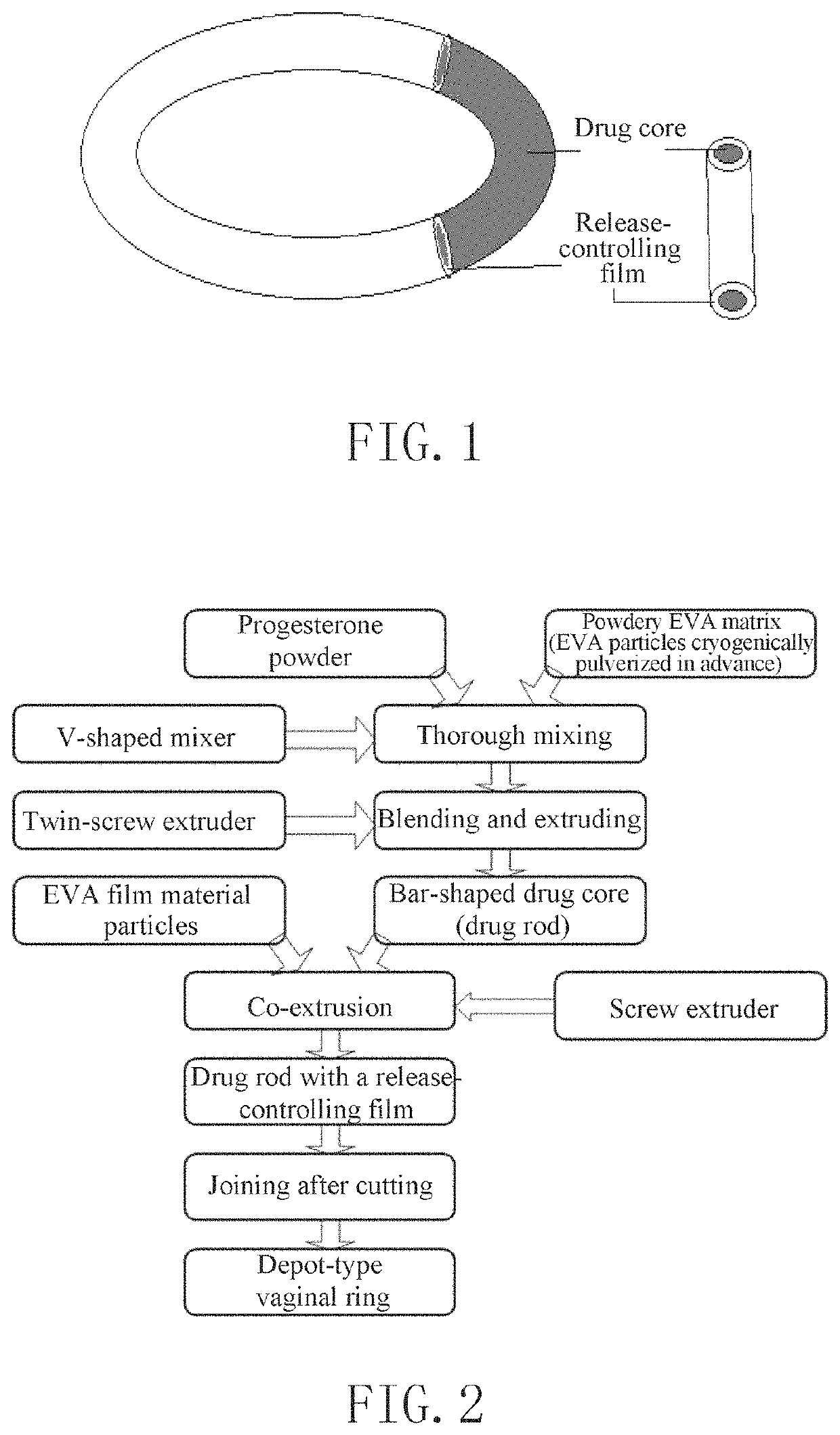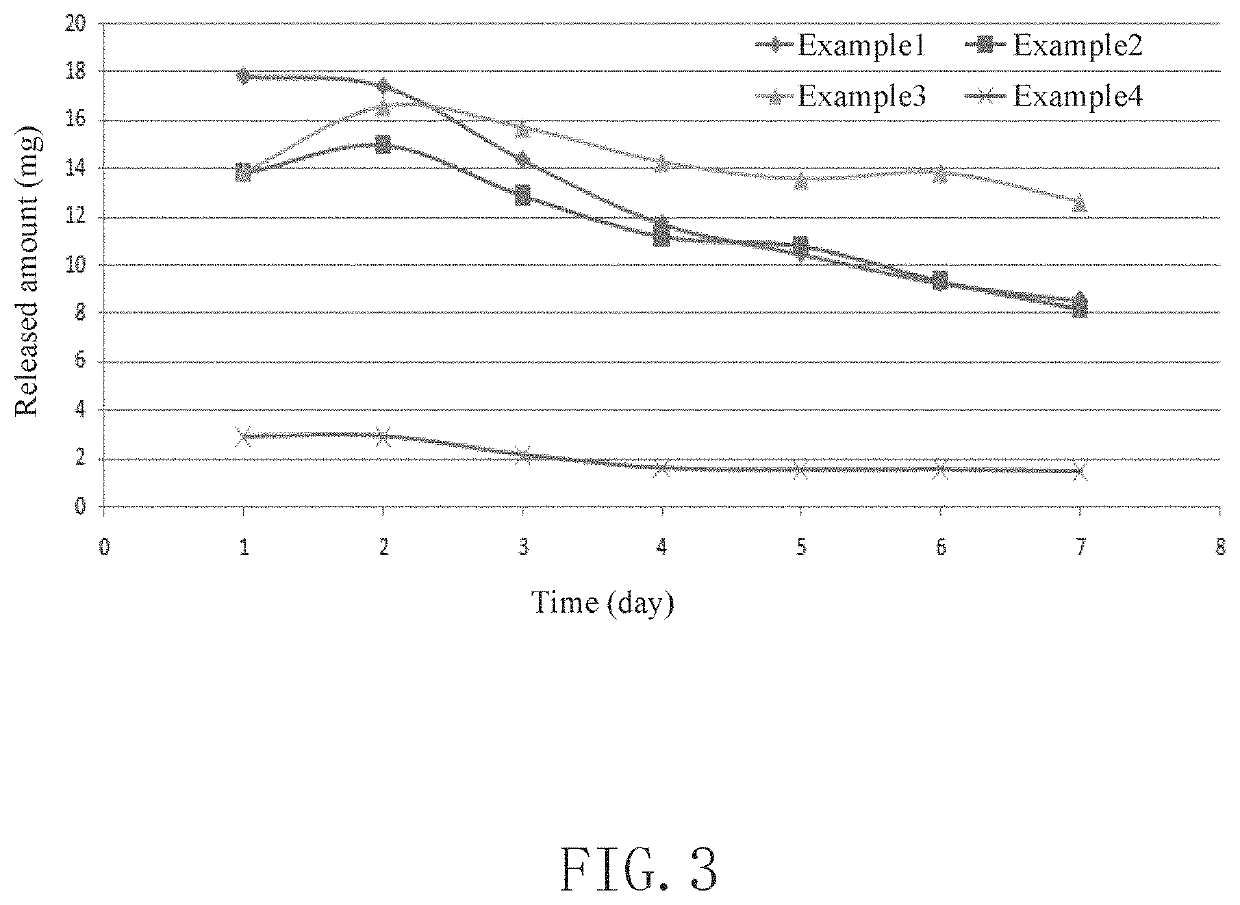Vaginal sustained-release drug delivery system for luteal support, method for preparation and use thereof
a drug delivery system and luteal support technology, applied in the field of assisted reproductive technology, can solve the problems of poor patient compliance, low pregnancy rate, skin inflammation and scab formation, etc., and achieve the effects of poor compliance, high manufacturing cost, and inadequate efficacy
- Summary
- Abstract
- Description
- Claims
- Application Information
AI Technical Summary
Benefits of technology
Problems solved by technology
Method used
Image
Examples
example 1
[0043]FIG. 1 shows the structure of the depot-type vaginal ring according to the present invention. FIG. 2 shows a process flow chart of the method for preparing the vaginal sustained-release drug delivery system for luteal support according to the present invention.
[0044]45 g of micronized progesterone and 150 g of powdery EVA33 (VA content 33%) matrix were mixed and stirred thoroughly for 5 minutes, and the mixture was then transferred to a conical twin-screw extruder in which the temperature was set at: 70° C. in the first zone, 80° C. in the second zone, and 75° C. in the third zone. The mixture was heated, melted, and extruded into a bar-like cylindrical drug core, while the conveyer speed was adjusted to control the thickness of the drug core between 4.0-4.4 mm, and the drug core was briefly cooled before neatly wound on a winding and unwinding device. Subsequently, approximately 20 g of an EVA33 (VA content 33%) film material was weighed and added into another screw extruder,...
example 2
[0046]40 g of micronized progesterone and 200 g of powdery EVA16 (VA content 33%) matrix were mixed and stirred thoroughly for 5 minutes, and the mixture was then transferred to a conical twin-screw extruder in which the temperature was set at: 108° C. in the first zone, 118° C. in the second zone, and 116° C. in the third zone. The mixture was heated, melted, and extruded into a bar-like cylindrical drug core, while the conveyer speed was adjusted to control the thickness of the drug core between 3.5-4.0 mm, and the drug core was briefly cooled before neatly wound on a winding and unwinding device. Subsequently, approximately 30 g of an EVA40 (VA content 40%) film material was weighed and added into another screw extruder, and the winding and unwinding device and the screw extruder (extrusion rate 10-20 rpm) were simultaneously started. The temperature of the extruder was set at: 45° C. in the first zone, 65° C. in the second zone, 85° C. in the third zone, and 95° C. in the fourth...
example 3
[0048]80 g of micronized progesterone and 200 g of powdery EVA40 (VA content 40%) matrix were mixed and stirred thoroughly for 5 minutes, and the mixture was then transferred to a conical twin-screw extruder in which the temperature was set at: 60° C. in the first zone, 70° C. in the second zone, and 65° C. in the third zone. The mixture was heated, melted, and extruded into a bar-like cylindrical drug core, while the conveyer speed was adjusted to control the thickness of the drug core between 4.4-4.7 mm, and the drug core was briefly cooled before neatly wound on a winding and unwinding device. Subsequently, approximately 40 g of an EVA18 (VA content 18%) film material was weighed and added into another screw extruder, and the winding and unwinding device and the screw extruder (extrusion rate 10-20 rpm) were simultaneously started. The temperature of the extruder was set at: 80° C. in the first zone, 100° C. in the second zone, 120° C. in the third zone, and 140° C. in the fourth...
PUM
 Login to View More
Login to View More Abstract
Description
Claims
Application Information
 Login to View More
Login to View More - R&D
- Intellectual Property
- Life Sciences
- Materials
- Tech Scout
- Unparalleled Data Quality
- Higher Quality Content
- 60% Fewer Hallucinations
Browse by: Latest US Patents, China's latest patents, Technical Efficacy Thesaurus, Application Domain, Technology Topic, Popular Technical Reports.
© 2025 PatSnap. All rights reserved.Legal|Privacy policy|Modern Slavery Act Transparency Statement|Sitemap|About US| Contact US: help@patsnap.com


